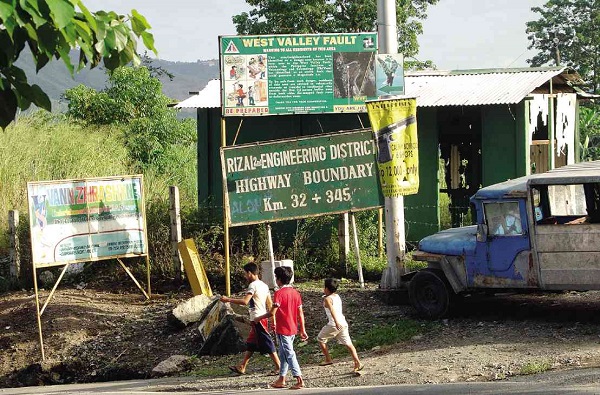Metro ready for Big One? Survey pushed

ONLY people not concerned about their safety would ignore the sign posted by the Quezon City government at its boundary with Rodriguez, Rizal province, which asks residents to move out of the area since it is near the West Valley Fault. ROMY HOMILLADA
Will buildings and houses in the metropolis withstand the “Big One?”
To determine the answer, Metropolitan Manila Development Authority (MMDA) Chair Francis Tolentino has called on local government units (LGUs) to do a Metro-wide earthquake census after a magnitude 7.2 earthquake jolted Bohol and Cebu provinces last week.
“In view of the clamor to revisit some of the provisions of the National Building Code, we should start this earthquake risk audit so we can plan and implement contingency measures in case a strong earthquake hits Metro Manila,” Tolentino said in a statement on Wednesday.
He noted that the earthquake risk survey would mainly identify public and private buildings, including residential houses, with structural deficiencies so that local engineers and building officials could implement corrective measures.
Similar to a population census, the earthquake survey should be simultaneously carried out by the 17 LGUs in Metro Manila, according to Tolentino who said they could start on this after the Oct. 28 barangay elections.
Article continues after this advertisementIn justifying the need to prepare for the Big One, the MMDA chair cited the findings of the Australian Agency for International Development (AusAid) which predicted that 37,000 people would perish in Metro Manila alone in the event of a 7.2-magnitude earthquake.
Article continues after this advertisementThe metropolis and other neighboring provinces sit on the West Marikina Valley Fault which experts from the Philippine Institute of Volcanology and Seismology (Phivolcs) said is ripe for movement.
In Makati, the city government through its Urban Development Department, is considering removing the structures which stand along the fault line in four barangays and evacuating the residents to a safe place.
According to the city’s Comprehensive Land Use Plan approved in August, a 10-meter easement along the fault zone will be converted into an open space and linear park.
However, Philippine Institute of Volcanology and Seismology (Phivolcs) Chief Renato Solidum warned that even cities far away from the fault line could still suffer massive destruction and loss of life.
“Damage will be widespread, even in Caloocan. You don’t need to be anywhere near a fault to experience an earthquake’s effects,” he told participants at a business conference organized by the Caloocan City government yesterday.
Solidum said that according to the worst-case scenario Phivolcs came up with in its most recent quake risk analysis released this year, around 3,100 of the 1.5 million people in the city could be killed and around 54,000 more injured should a 7.2-magnitude earthquake hit Metro Manila.
On the other hand, 5.6 million square meters or about 10 percent of the city’s land area may end up being destroyed and the city will need about P119 billion to rebuild all the damaged buildings.
The dead and injured represent just eight percent of the estimated 37,000 dead and 604,000 injured in the metropolis and neighboring Rizal province.
To arrive at this scenario, Solidum said Phivolcs analyzed the location of buildings and the composition of the ground where they stand, the use of these structures, materials used and the number of people occupying these buildings.